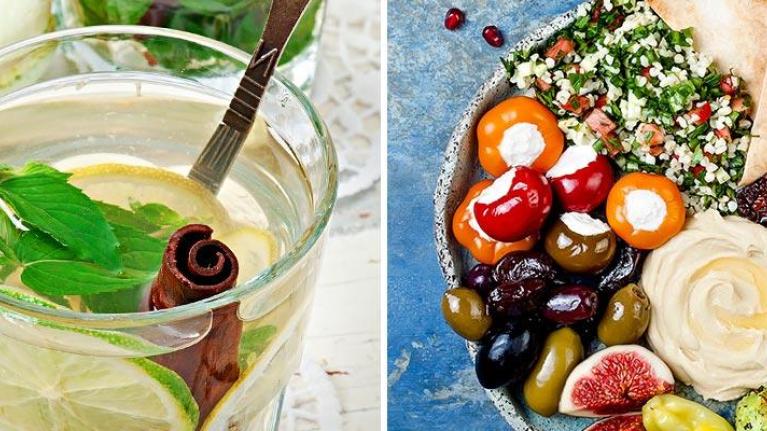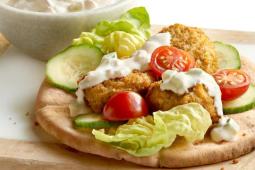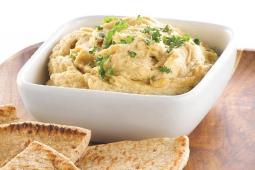
Middle Eastern Fare Takes the Spotlight
Lots of vegetables and loads of flavor are the hallmarks of Middle Eastern foods. Learn how to incorporate this healthful and eye-appealing cuisine in your operation.
Hot on the heels of the Mediterranean trend comes a more specialized interest in the food and beverages of the Middle East. Healthy, vegetable-focused, and full of flavorful ingredients like olives, tahini, yogurt, za’atar, pomegranate, preserved lemons, and more, the cuisine of countries like Lebanon, Israel, Turkey, and Egypt is exotic yet approachable, and completely right for the times.
Spices, Condiments, and Sauces
Spice blends, condiments, and sauces represent a great point of entry for Eastern cuisine. These and other ingredients provide the Middle Eastern flavor palette.
- Za’atar is a popular spice mix blended from ground dried thyme, oregano, marjoram, and lemony sumac, mixed with toasted sesame seeds and salt. It can be served as is with olive oil for a bread dip, mixed with a dressing, or used to provide a flavorful crust for proteins
- Tahini is the staple sesame butter that forms the backbone of hummus, both of which can be used in dressings, on sandwiches, grilled meats and vegetables, and in many other applications
- Harissa is a versatile North African and Middle Eastern condiment with many regional variations, but usually includes hot chile peppers (which are often smoked), garlic, olive oil, and spices like cumin, coriander, caraway, and mint
- Chermoula is a marinade and sauce that gets its character from cilantro, parsley, mint, lemon, cumin, olive oil, and red pepper. It can be incorporated into the cooking process, or added before serving as a sauce
- Preserved lemons are made by packing quartered lemons in salt with their juice, and allowing them to cure for several weeks. Fruit, peel, and juice can then be used in salads, marinades, chicken and seafood dishes, and anywhere that could use a lift of acidity and flavor
For more on Middle Eastern flavors and ingredients, see below.
Beverages
The Middle Eastern love of bold flavors, spices, and fruit is also seen in the region's beverages, such as thick, strong Turkish coffee, and tea with mint and cinnamon.
- Iced Hibiscus Tea
- Lemonade with Orange Blossom Water and Mint
- Cardamom Tea with Saffron
- Green Tea with Apple, Lemon, and Cinnamon
- Moroccan Cinnamon Tea
- Turkish Coffee
- Moroccan Mint Tea
- Karak Tea with Condensed Milk and Cardamom
Dips
Flavorful creamy dips are part of the Middle Eastern tradition of mezze, a tapas-like social occasion that can also be accompanied by olives, feta cheese, vegetables like stuffed grape leaves, and the ubiquitous flatbread. Many of these can be used as a sauce on sandwiches and in salads.
- Hummus—This traditional chickpea-and-tahini spread fulfills a central role, but hummus has also been innovated to feature other ingredients, such as edamame, black beans, and vegetables such as carrots
- Tzatziki—Rich yet refreshing, thick yogurt or labneh is combined with cucumbers, garlic, olive oil, and fresh herbs like dill and mint
- Baba Ghanoush—Roasted eggplant lends a smoky flavor to this creamy dip that also contains tahini, olive oil, and parsley. Garnish with pomegranate seeds for beautiful color and a burst of flavor
- Muhammara—This chunky, tangy nut dip usually contains crushed walnuts, Aleppo pepper, pomegranate syrup, and bread crumbs
Sandwiches
Traditional rolled and folded flatbread sandwiches are among the most easily translatable Middle Eastern specialties.
- Shawarma, aka doner kebab or gyros, is made from thinly sliced lamb, beef, or chicken, marinated in yogurt and spices, then grilled. Shawarma is commonly served in pita or lavash flatbread with tahini, yogurt sauce, or garlic mayonnaise. Other garnishes include chopped tomatoes, sliced cucumbers, shredded lettuce, sliced red onion, pickles, mango pickle, hummus, or even French fries
- Falafel are a popular street food specialty consisting of fried balls or ovals of ground chickpeas or fava beans. They are stuffed into warm pita along with fresh and pickled vegetables, herbs, Greek yogurt, and lemon garlic tahini dressing, and drizzled with hot sauce if desired
Tip: Almost any filling, from tuna salad to grilled vegetables, can be given a Middle Eastern treatment with flatbread and such garnishes as cucumber and tomato, feta cheese, tahini, yogurt, and quick pickled onions.
Grain Specialties
Grains like farro, bulgur, couscous, and basmati rice help give Middle Eastern cuisine its healthy reputation.
- Tabbouleh—A Levantine vegetarian salad made mostly of finely chopped parsley with tomatoes, mint, onion, bulgur (soaked, not cooked), and seasoned with olive oil, lemon juice, salt, and pepper. The basic recipe can also be applied to quinoa, barley, couscous, or another grain
- Mejadra—From Israel, this comforting combination of lentils and rice with fried onions, cumin, cinnamon, and other fragrant spices deserves wider recognition
- Pilaf—Though popular in many parts of the world, this versatile dish of rice cooked with stock and spices is especially well-known in the Middle East. The Lebanese version is made with the addition of thin vermicelli noodles, and more elaborate versions can include onion, saffron, pistachios, and other ingredients
Sources: Datassential SNAP! (2019); Datassential Hot Tea Menu Adoption Cycle (2018)
The information provided is based on a general industry overview, and is not specific to your business operation. Each business is unique and decisions related to your business should be made after consultation with appropriate experts.
- Za’atar has experienced four-year growth on menus of 200.3%
- Hummus has found a place on 14.8% of US menus
- Menu mentions of the thickened yogurt known as labneh have grown 68.4% since 2014
- Hibiscus tea has begun to proliferate on chain restaurants and mainstream grocery stores
- Learn how to cook ancient grains with this convenient cooking table.
- Hummus is a versatile dip/spread that can bring Middle Eastern flavor to small plates, sandwiches, samplers, and other menu items—or simply serve as-is with pits and crudité. Try one of these basic recipes for Roasted Garlic Hummus or Jalapeño Hummus, and get creative from there.




